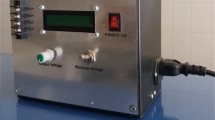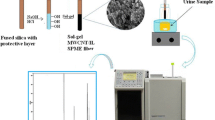Abstract
Antimicrobial peptides (AMPs) are best known for their bactericidal properties; however, due to their unique and flexible structures, they have also been proposed as potential selective sorbents for specific molecules. In the present study, we aimed to design and produce a new peptide-based microextraction fiber for preconcentrating morphine in urine samples. The binding of morphine to the peptide was first evaluated by computational simulation using the Molecular Operating Environment (MOE) 2015.10 software. A similar study was then performed using DS BIOVIA Materials Studio 2017 v17.1.0.48, which confirmed the results of the simulation carried out with MOE. Afterwards, those results were also confirmed by experimental research. In the experimental evaluation, carbon nanotubes (CNTs) were initially carboxylated with H2SO4/HNO3 (3:1) and then functionalized with the peptide. FTIR analysis, Raman measurements, and SEM imaging were used to confirm that CNT functionalization was successful as well as to check the nanostructure of the fiber. To evaluate the functionality of the fiber, it was inserted into a microtube containing a urine sample that included morphine and then sonicated for 5 min at 40 °C. Afterwards, the fiber was washed with methanol 20% (H2O/methanol) and the resulting sample was analyzed by HPLC. This procedure was repeated for different concentrations of morphine in the urine sample. The computational and experimental results showed that a morphine concentration as low as 0.25 ppb in urine could be adsorbed and detected using the peptide fiber. Therefore, given its semi-selective binding affinity for morphine, this peptide-based fiber can be considered a new approach to the detection of small amounts of morphine in biological samples.










Similar content being viewed by others
References
Attari SG, Bahrami A, Shahna FG, Heidari M (2014) Solid-phase microextraction fiber development for sampling and analysis of volatile organohalogen compounds in air. J Environ Health Sci Eng 12(1):123. https://doi.org/10.1186/s40201-014-0123-5
Riahi-Zanjani B, Balali-Mood M, Asoodeh A, Es'haghi Z, Ghorani-Azam A (2018) Developing a new sensitive solid-phase microextraction fiber based on carbon nanotubes for preconcentration of morphine. Appl Nanosci 8(8):2047–2056. https://doi.org/10.1007/s13204-018-0882-x
Le CF, Fang CM, Sekaran SD (2017) Intracellular targeting mechanisms by antimicrobial peptides. Antimicrob Agents Chemother 61(4). https://doi.org/10.1128/AAC.02340-16
Schmitt P, Rosa RD, Destoumieux-Garzon D (2016) An intimate link between antimicrobial peptide sequence diversity and binding to essential components of bacterial membranes. Biochim Biophys Acta 1858(5):958–970. https://doi.org/10.1016/j.bbamem.2015.10.011
Asoodeh A, Sepahi S, Ghorani-Azam A (2014) Purification and modeling amphipathic alpha helical antimicrobial peptides from skin secretions of Euphlyctis cyanophlyctis. Chem Biol Drug Des 83(4):411–417. https://doi.org/10.1111/cbdd.12256
Asoodeh A, Ghorani-Azam A, Chamani J (2012) Identification and characterization of novel antibacterial peptides from skin secretions of euphlyctis cyanophlyctis. Int J Pept Res Ther 18(2):107–115. https://doi.org/10.1007/s10989-011-9284-6
Li J, Koh JJ, Liu S, Lakshminarayanan R, Verma CS, Beuerman RW (2017) Membrane active antimicrobial peptides: translating mechanistic insights to design. Front Neurosci 11:73. https://doi.org/10.3389/fnins.2017.00073
Spee P, Neefjes J (1997) TAP-translocated peptides specifically bind proteins in the endoplasmic reticulum, including gp96, protein disulfide isomerase and calreticulin. Eur J Immunol 27(9):2441–2449. https://doi.org/10.1002/eji.1830270944
Reinhardt A, Neundorf I (2016) Design and application of antimicrobial peptide conjugates. Int J Mol Sci 17(5). https://doi.org/10.3390/ijms17050701
Ghorani-Azam A, Balali-Mood M, Aryan E, Karimi G, Riahi-Zanjani B (2018) Effect of amino acid substitution on biological activity of cyanophlyctin-β and brevinin-2R. J Mol Struct 1158:14–18. https://doi.org/10.1016/j.molstruc.2018.01.015
Reverdatto S, Burz DS, Shekhtman A (2015) Peptide aptamers: development and applications. Curr Top Med Chem 15(12):1082–1101
Xu X, Zhou J, Liu X, Nie Z, Qing M, Guo M, Yao S (2012) Aptameric peptide for one-step detection of protein kinase. Anal Chem 84(11):4746–4753. https://doi.org/10.1021/ac3001918
Johnson S, Evans D, Laurenson S, Paul D, Davies AG, Ko Ferrigno P, Walti C (2008) Surface-immobilized peptide aptamers as probe molecules for protein detection. Anal Chem 80(4):978–983. https://doi.org/10.1021/ac701688q
Rothe M, Pragst F (1995) Solvent optimization for the direct extraction of opiates from hair samples. J Anal Toxicol 19(4):236–240
Paul BD, Shimomura ET, Smith ML (1999) A practical approach to determine cutoff concentrations for opiate testing with simultaneous detection of codeine, morphine, and 6-acetylmorphine in urine. Clin Chem 45(4):510–519
Paul BD, Mitchell JM, Mell JLD, Irving J (1989) Gas chromatography/electron impact mass fragmentometric determination of urinary 6-acetylmorphine, a metabolite of heroin. J Anal Toxicol 13(1):2–7. https://doi.org/10.1093/jat/13.1.2
Fuller DC, Anderson WH (1992) A simplified procedure for the determination of free codeine, free morphine, and 6-acetylmorphine in urine. J Anal Toxicol 16(5):315–318. https://doi.org/10.1093/jat/16.5.315
Ahadi A, Partoazar A, Abedi-Khorasgani M-H, Shetab-Boushehri SV (2011) Comparison of liquid-liquid extraction-thin layer chromatography with solid-phase extraction-high-performance thin layer chromatography in detection of urinary morphine. J Biomed Res 25(5):362
Rezai-Basiri M, Ghazi-Khansari M, Faghih A, Sadeghi M, Lotfalizadeh N, Eghbal M, Mohajell-Nayebi A, Rezazadeh H, Zadeh MA (2010) Screening of morphine and codeine in urine of opioid abusers by rapid and TLC analysis. Eur J Gen Med 7(2):192–196
Elkon KB (1992) Use of synthetic peptides for the detection and quantification of autoantibodies. Mol Biol Rep 16(3):207–212
Ryu K, Haes AJ, Park H-Y, Nah S, Kim J, Chung H, Yoon M-Y, Han S-H (2010) Use of peptide for selective and sensitive detection of an Anthrax biomarker via peptide recognition and surface-enhanced Raman scattering. J Raman Spectrosc 41:121–124. https://doi.org/10.1002/jrs.2591
Neupane LN, Oh ET, Park HJ, Lee KH (2016) Selective and sensitive detection of heavy metal ions in 100% aqueous solution and cells with a fluorescence chemosensor based on peptide using aggregation-induced emission. Anal Chem 88(6):3333–3340. https://doi.org/10.1021/acs.analchem.5b04892
Wang P, Wu J, Di C, Zhou R, Zhang H, Su P, Xu C, Zhou P, Ge Y, Liu D, Liu W, Tang Y (2017) A novel peptide-based fluorescence chemosensor for selective imaging of hydrogen sulfide both in living cells and zebrafish. Biosens Bioelectron 92:602–609. https://doi.org/10.1016/j.bios.2016.10.050
In B, Hwang GW, Lee KH (2016) Highly sensitive and selective detection of Al(III) ions in aqueous buffered solution with fluorescent peptide-based sensor. Bioorg Med Chem Lett 26(18):4477–4482. https://doi.org/10.1016/j.bmcl.2016.07.073
Tomar K, Kaur G, Verma S, Ramanathan G (2018) A self-assembled tetrapeptide that acts as a “turn-on” fluorescent sensor for Hg2+ ion. Tetrahedron Lett 59:3653–3656. https://doi.org/10.1016/j.tetlet.2018.08.043
He X, Wang X, Zhang L, Fang G, Liu J, Wang S (2018) Sensing and intracellular imaging of Zn2+ based on affinity peptide using an aggregation induced emission fluorescence “switch-on” probe. Sensors Actuators B Chem 271:289–299. https://doi.org/10.1016/j.snb.2018.05.082
Acknowledgments
The results described in this paper were part of the corresponding author’s Ph.D. thesis. The research project was supported by the Vice Chancellorship for Research, Mashhad University of Medical Sciences (grant no: 930829).
Author information
Authors and Affiliations
Corresponding author
Ethics declarations
Conflict of interest
There is no conflict of interest between the authors.
Additional information
Publisher’s note
Springer Nature remains neutral with regard to jurisdictional claims in published maps and institutional affiliations.
Rights and permissions
About this article
Cite this article
Riahi-Zanjani, B., Balali-Mood, M., Es’haghi, Z. et al. Molecular modeling and experimental study of a new peptide-based microextraction fiber for preconcentrating morphine in urine samples. J Mol Model 25, 54 (2019). https://doi.org/10.1007/s00894-019-3925-7
Received:
Accepted:
Published:
DOI: https://doi.org/10.1007/s00894-019-3925-7




